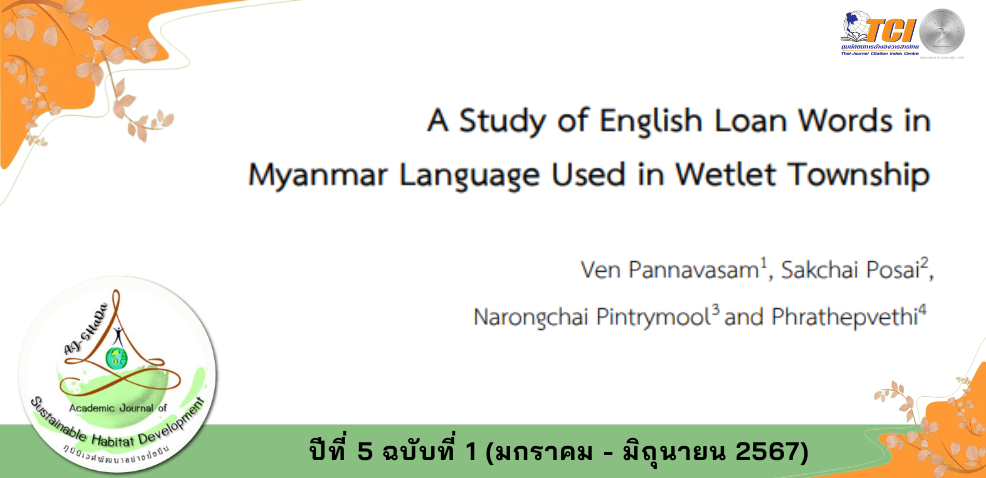A Study of English Loan Words in Myanmar Language Used in Wetlet Township
Main Article Content
บทคัดย่อ
The Objective of this research are: 1) To study of English loanword used by Myanmar language in Wetlet Township, 2) To find out the difficulties of English loanwords used by Myanmar people in Wetlet Township, 3) To find out for frequency of loanwords use of different careers. The research involved a target population of 60 people in Wetlet Township of Myanmar, all of whom participated in the study. The study followed both quantitative and qualitative research methodology employing the questionnaire, in-depth interview, and additional comments. All data from the 60 people was analyzed by using Statistical Package for the Social Sciences version by means of frequency, percentage, mean, and standard deviation (S.D.).
The result of research found as follows: This research aimed to analyze the extent to which English words have been adopted and adapted within the local linguistic context. By examining the usage patterns and semantic shifts of these loanwords, the study sought to gain insights into the sociolinguistic dynamics and cultural influences that contribute to the integration of English vocabulary into the language spoken in Wetlet Township.
This study was conducted to explore the challenges and obstacles faced by the residents of Wetlet Township in integrating English loanwords into their everyday language. This research endeavors to explore the specific difficulties encountered by Myanmar speakers in the adoption and adaptation of English loanwords within the linguistic context of Wetlet Township.
This research was designed with the primary objective of examining that All interviewed the overall levels of agreement with the twenty statements were generally positive. Specifically: Statement number one, nine and eighteen received a moderately high level of agreement, with a mean score of 3.38, indicating that the majority of respondents leaned towards agreement. Statements number one, nine and eighteen except all received high overall agreement levels, with mean scores ranging from 3.55 to 4.05, suggesting strong agreement from the majority of participants for each statement.
Article Details

อนุญาตภายใต้เงื่อนไข Creative Commons Attribution-NonCommercial-NoDerivatives 4.0 International License.
เอกสารอ้างอิง
Ashley, S & Marie, L. (2016). Language, Education and the Peace Process in Myanmar. Contemporary Southeast Asia, 38(1), 128-153.
Danesi, M. & Rocci, A. (2009). Global Linguistics: An Introduction. Berlin: Mouton de Gruyter.
Hall-Lew, L.A. (2002). English Loanwords in Mandarin Chinese. (Thesis of B.A. Linguistics). The University of Arizone, United States of America.
Hla, T. (2009). A History of Modern. Cambridge: Cambridge University Press.
Hoffer, B.L. (2005). Language Borrowing and the Indices of Adaptability and Receptivity. Intercultural Communication Studies, 14(2), 53.
Mitan, C. (2016). A Study of English Loanwords Spoken in Chakma Language in Bangladesh. (Thesis of M.A. Linguistics). Mahaculalong-kornrajavidyalaya University, Phra Nakhon Si Ayutthaya Province.
Phra Nawseng, A. (2021). An Analytical Study of Burmese Loanwords in Shan Language. (Dissertation of Ph.D. Linguistics). Mahaculalongkornrajavidya laya University, Phra Nakhon Si Ayutthaya Province.
Rachaneewan, K. (2017). An Analysis of English Loan Words Used in Entertainment News in Thai Daily Newspapers. Thesis of M.A. (English). University of Phayao, Phayao Province.
Richard,V. (2018). The Importance of Language. Oxford: Oxford University Press.
Trask, R.L. (1996). Historical Linguistics. London: Arnold.


